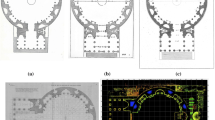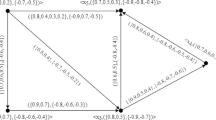Abstract
As an intermediate category between metric and topology, directional relations are as much varied as “right of”, “before”, “between”, “in front of”, “back”, “north of”, “east of”, and so on. Directional relations are ambiguous if taken alone without the contextual information described by frames of reference. In this paper, we identify a unifying framework for directional relations and frames of reference, which shows how a directional relation with its associated frame of reference can be mapped to a projective relation of the 5-intersection model. We discuss how this knowledge can be integrated in spatial query languages.











Similar content being viewed by others
References
Bloch I, Ralescu A (2003) Directional relative position between objects in image processing: a comparison between fuzzy approaches. Pattern Recognit 36:1563–1582
Liu X, Shekhar S, Chawla S (2003) Object-based directional query processing in spatial databases. IEEE Trans Knowl Data Eng 15(2):295–304
Worboys M, Duckham M, Kulik L (2004) Commonsense notions of proximity and direction in environmental space. Spat Cogn Comput 4(4):285–312
Wolter D, Lee JH (2010) Qualitative reasoning with directional relations. Artif Intell 174:1498–1507
Clementini E, Di Felice P, Hernández D (1997) Qualitative representation of positional information. Artif Intell 95(2):317–356
Frank AU (1992) Qualitative reasoning about distances and directions in geographic space. J Vis Lang Comput 3(4):343–371
Freksa C (1992) Using orientation information for qualitative spatial reasoning. In: Frank AU, Campari I, Formentini U (eds) Theories and methods of spatio-temporal reasoning in geographic space - International Conference GIS - From space to territory: theories and methods of spatio-temporal reasoning, September 21–23, 1992, Pisa, Italy, vol 639. LNCS. Springer, Berlin, pp 162–178
Hernández D (1993) Maintaining qualitative spatial knowledge. In: Frank AU, Campari I (eds) Spatial information theory: a theoretical basis for GIS - European conference, COSIT’93, vol 716. LNCS. Springer-Verlag, Berlin, pp 36–53
Ligozat GF (1993) Qualitative triangulation for spatial reasoning. In: Frank AU, Campari I (eds) Spatial information theory: a theoretical basis for GIS: European conference, COSIT’93, September 19–22, 1993, Marciana Marina, Elba Island, Italy, vol 716. LNCS. Springer Verlag, Berlin, pp 54–68
Schlieder C (1995) Reasoning about ordering. In: Frank AU, Kuhn W (eds) Spatial information theory: a theoretical basis for GIS - Int. Conf., COSIT’95, vol 988. LNCS. Springer, Berlin, pp 341–349
Goyal R, Egenhofer MJ (1997) The direction-relation matrix: a representation of direction relations for extended spatial objects. In: UCGIS annual assembly and summer retreat, Bar Harbor, ME
Clementini E, Billen R (2006) Modeling and computing ternary projective relations between regions. IEEE Trans Knowl Data Eng 18(6):799–814
Levinson SC (1996) Frames of reference and Molyneux’s question: crosslinguistic evidence. In: Bloom P, Peterson MA, Nadel L, Garrett MF (eds) Language and space. The MIT Press, Cambridge, Massachussets, pp 109–169
Klatzky RL (1998) Allocentric and egocentric spatial representations: definitions, distinctions, and interconnections. In: Freksa C, Habel C, Wender KF (eds) Spatial cognition: an interdisciplinary approach to representing and processing spatial knowledge vol 1404. Lecture Notes in Artificial Intelligence. Springer, Berlin, pp 1–17
Frank AU (1998) Formal models for cognition — Taxonomy of spatial location description and frames of reference. In: Freksa C, Habel C, Wender KF (eds) Spatial cognition: an interdisciplinary approach to representing and processing spatial knowledge vol 1404. Lecture Notes in Artificial Intelligence. Springer, Berlin, pp 293–312
Hernández D (1994) Qualitative representation of spatial knowledge, vol 804. Lecture Notes in Artificial Intelligence. Springer, Berlin
Eschenbach C (1999) Geometric structures of frames of reference and natural language semantics. Spat Comput Cogn 1(4):329–348
Eschenbach C, Habel C, Leßmöllmann A (1997) The interpretation of complex spatial relations by integrating frames of reference. Paper presented at the Workshop “Language and Space” (AAAI-97), Rhode Island
Moratz R, Tenbrink T (2006) Spatial reference in linguistic human-robot interaction: iterative, empirically supported development of a model of projective relations. Spat Cogn Comput 6(1):63–107
Retz-Schmidt G (1988) Various views on spatial prepositions. AI Mag 9(2):95–105
Cohn AG, Renz J (2007) Qualitative spatial representation and reasoning. In: Harmelen Fv, Lifschitz V, Porter B (eds) Handbook of knowledge representation, 1. Elsevier, pp 551–596
Bloch I, Colliot O, Cesar RM Jr (2006) On the ternary spatial relation “Between”. IEEE Trans Syst Man Cybern B Cybern 36(2):312–327
Majid A, Bowerman M, Kita S, Haun DBM, Levinson SC (2004) Can language restructure cognition? The case for space. Trends Cogn Sci 8(3):108–114
Gallistel CR (2002) Language and spatial frames of reference in mind and brain. Trends Cogn Sci 6(8):321–322
Cai G (2007) Contextualization of geospatial database semantics for Human–GIS Interaction. GeoInformatica 11(2):217–237
Ishikawa T, Kiyomoto M (2008) Turn to the left or to the west: verbal navigational directions in relative and absolute frames of reference. In: Cova TJ, Miller HJ, Beard K, Frank AU, Goodchild MF (eds) Geographic information science, 5th International Conference, GIScience 2008, Park City, UT, USA, September 23–26, 2008., vol 5266. LNCS. Springer, Berlin, pp 119–132
Klippel A, Montello DR (2007) Linguistic and nonlinguistic turn direction concepts. In: Winter S, Duckham M, Kulik L, Kuipers B (eds) Spatial Information theory, 8th International Conference, COSIT 2007, Melbourne, Australia, September 19–23, 2007, vol 4736. LNCS. Springer, Berlin, pp 354–372
Stewart Hornsby K, King K (2008) Modeling motion relations for moving objects on road networks. GeoInformatica 12(4):477–495
Varzi A (1996) Parts, wholes, and part-whole relations: the prospects of mereotopology. Data Knowl Eng 20(3):259–286
Clementini E, Di Felice P (1997) A global framework for qualitative shape description. GeoInformatica 1(1):1–17
Clementini E, Di Felice P (2000) Spatial operators. ACM SIGMOD Rec 29(3):31–38
Billen R, Clementini E (2005) Semantics of collinearity among regions. In: Meersman R, Tari Z, Herrero P (eds) On the move to meaningful internet systems 2005: OTM workshops - 1st Int. Workshop on semantic-based geographical information systems (SeBGIS’05), Agia Napa, Cyprus, October 31 - November 4, 2005, vol 3762. LNCS. Springer, Berlin, pp 1066–1076
Jackendoff R (1996) The architecture of the linguistic-spatial interface. In: Bloom P, Peterson MA, Nadel L, Garrett MF (eds) Language and space. The MIT Press, Cambridge, Massachussets, pp 1–30
Kulik L, Klippel A (1999) Reasoning about cardinal directions using grids as qualitative geographic coordinates. In: Freksa C, Mark DM (eds) Spatial Information Theory: Cognitive and Computational Foundations of Geographic Information Science: International Conference COSIT ’99, August 25–29, 1999, Stade, Germany, vol 1661. LNCS. Springer, Berlin, pp 205–220
Levelt WJM (1996) Perspective taking and ellipsis in spatial descriptions. In: Bloom P, Peterson MA, Nadel L, Garrett MF (eds) Language and space. The MIT Press, Cambridge, Massachussets, pp 77–107
OGC Open Geospatial Consortium Inc (2005) OpenGIS Web Feature Service (WFS) Implementation specification. OGC 04–094:131
OGC Open Geospatial Consortium Inc (2007) OpenGIS Geography Markup Language (GML) Encoding Standard. http://www.opengeospatial.org/standards/gml. Accessed 05.12.2008
Vivid Solutions Inc (2004) JTS Topology Suite. http://www.vividsolutions.com/jts/JTSHome.htm. Accessed 05.12.2008
Acknowledgements
We thank the anonymous reviewers and the area editor for suggesting important new insights to the first submitted version of this paper.
Author information
Authors and Affiliations
Corresponding author
Rights and permissions
About this article
Cite this article
Clementini, E. Directional relations and frames of reference. Geoinformatica 17, 235–255 (2013). https://doi.org/10.1007/s10707-011-0147-2
Received:
Revised:
Accepted:
Published:
Issue Date:
DOI: https://doi.org/10.1007/s10707-011-0147-2




